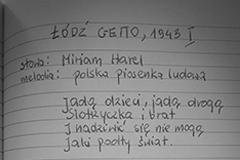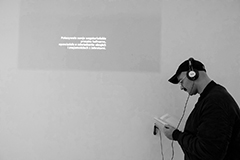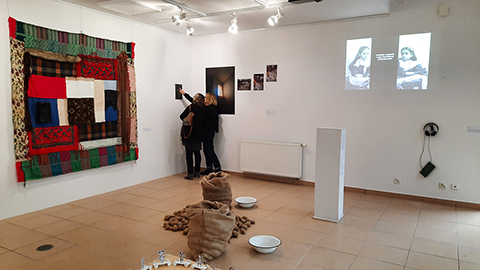Anka Leśniak
works
biography texts contact
2021
2020
2019
2018
2017
2016
2015
2014
2013
2012
2011
2010
2009
2008
2007
2006
2004
WORKS 2021
Kafka's Sistrs
slideshow, object, sound - ready-made, 2021
Kafka's Sisters,
exhibition of the Frakcja group of artists
and invited artists from the Endmoräne group
Stara Wozownia - exhibition space of the University of Lodz, 2021
organiser: Marek Edelman Dialogue Center in Lodz
On October 17, 1941, after a 30-hour journey, a train carrying Gabriele Hermann arrived at the Radegast station in Litzmannstadt, the city of Łódź in Poland, renamed by German occupiers. On November 1, at 4:30 p.m., the fourth transport arrived, bringing Valerie Pollak and her husband, Josef, to the ghetto. These are among the last recorded mentions of Franz Kafka's sisters found in the archives. The preserved documents suggest that both women were murdered in a German extermination camp in Chełmno nad Nerem (Kulmhof). Kafka also had a third sister, Ottilie David, who was murdered in Auschwitz after being sent there in a transport with children she had cared for in the Theresienstadt camp.
Gabriele and Valerie were brought to the Litzmannstadt ghetto as an adult woman. However, I chose to use this mesmerizing photograph from their childhood, which reminded me of the imagery of the triple goddess. The girls have serious expressions on their faces and sharp gazes. Knowing that I was looking at three children for whom life was beginning while also being painfully aware of how they would die created a feeling that was hard to describe — oppressive and haunting. The images of the sisters are intertwined with descriptions of their personalities, which Hélène Zylberberg introduces in her text, "Das tragische Ende der drei Schwestern Kafkas" (The tragic end of Kafka's three sisters).









The slideshow titled "Kafka's Sisters" was complemented by Miriam Harel's Songbook. Miriam Goldberg (her married name is Harel), a resident of Łódź, was also imprisoned in the ghetto. After the war, she became a writer, translator, and poet in Israel and visited Poland many times as a witness to history.
Miriam's texts provide insight into daily life in the ghetto and the emotions experienced by a young girl—pain, fear, anger, and regret. She wrote these moving testimonies, found in her poetic works, to the melodies of Polish folk songs that express joy and carefreeness.


These works were part of an exhibition of contemporary art that reflected on past events and posed questions about modern mechanisms of violence, including the roles of political, historical, and social narratives that contribute to it.

Exhibition view